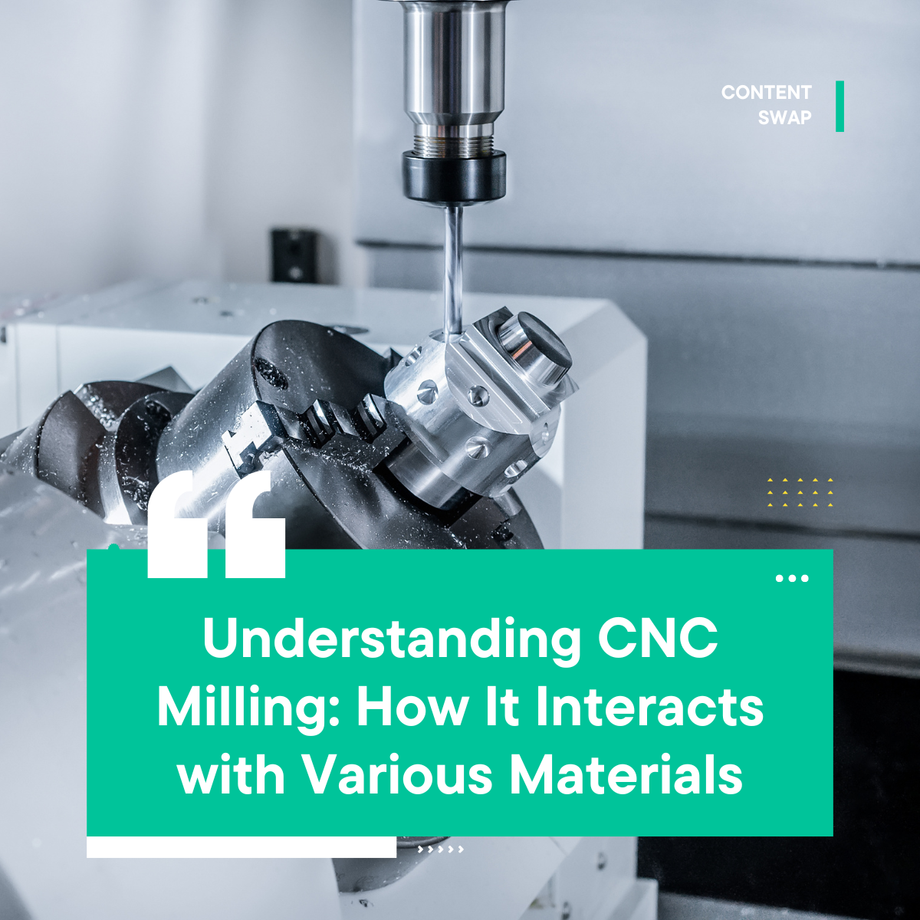CNC (Computer Numerical Control) milling is a manufacturing process that utilizes computerized controls and rotating multi-point cutting tools to remove material from a workpiece. The efficiency and accuracy of CNC milling make it a preferred method for industries ranging from aerospace to medical device manufacturing. However, the performance and characteristics of CNC milling depend significantly on the type of material being processed. This article explores how CNC milling interacts with different materials, including metals, plastics, composites, and wood, and the challenges and techniques used for each.
 |
CNC Milling: How It Interacts with Various Materials |
CNC Milling and Metals
Metals are among the most commonly milled materials due to their strength and durability. However, different metals exhibit distinct properties that influence the milling process.
1. Aluminum
Aluminum is a widely used material in CNC milling due to its lightweight, corrosion resistance, and excellent machinability. It requires relatively low cutting forces, allowing for high-speed machining. The key considerations when milling aluminum include:
- Using sharp carbide tools to prevent material buildup
- Applying coolant to avoid overheating and to improve surface finish
- Utilizing high spindle speeds and feed rates to optimize efficiency
2. Steel (Carbon and Stainless)
Steel, including carbon steel and stainless steel, is tougher to machine than aluminum due to its hardness and strength.
- Carbon Steel: Requires robust tooling such as coated carbide or high-speed steel (HSS) cutters.
- Stainless Steel: More challenging to mill because of its work-hardening properties, requiring reduced feed rates, sharp cutting tools, and lubrication to prevent overheating and tool wear.
3. Titanium
Titanium is commonly used in aerospace and medical applications due to its high strength-to-weight ratio and corrosion resistance. However, its poor thermal conductivity makes it prone to heat buildup, leading to rapid tool wear. Effective strategies for milling titanium include:
- Using low cutting speeds and moderate feed rates
- Applying high-pressure coolant systems to dissipate heat
- Employing specialized coatings like TiAlN (Titanium Aluminum Nitride) for tools
4. Brass and Copper
Both brass and copper are highly machinable materials used in electrical components and decorative applications. They require specific considerations:
- Brass is relatively easy to machine and allows for high-speed cutting with minimal tool wear.
- Copper, being softer and more ductile, can cause chip adhesion; hence, sharp tools and proper cooling are essential.
CNC Milling and Plastics
Plastics are another category of materials frequently machined using CNC milling. They vary in properties such as hardness, flexibility, and thermal stability.
1. Acrylic
Acrylic is used for clear components like signage and display cases. It requires:
- Sharp single-flute tools to minimize chipping
- Proper cooling to prevent melting due to heat buildup
- High spindle speeds and moderate feed rates for smooth edges
2. ABS (Acrylonitrile Butadiene Styrene)
ABS is a common engineering plastic used for prototyping and consumer products. It is prone to melting if the cutting temperature is too high. Best practices include:
- Using high-speed, low-feed cutting to reduce heat buildup
- Employing compressed air or minimal coolant to maintain workpiece stability
3. Nylon
Nylon is widely used in mechanical applications due to its wear resistance and toughness. However, it can absorb moisture and expand, affecting dimensional accuracy. Milling nylon effectively involves:
- Ensuring dry conditions for machining
- Using sharp tools to minimize frictional heating
- Implementing adequate chip evacuation techniques
4. Polycarbonate
Polycarbonate is tougher than acrylic and more impact-resistant. However, it is prone to stress cracking. Milling strategies include:
- Using sharp carbide tools to reduce cutting forces
- Maintaining moderate feed rates to prevent overheating
CNC Milling and Composite Materials
Composites consist of two or more materials combined to enhance specific properties. CNC milling of composites presents unique challenges due to their heterogeneous nature.
1. Carbon Fiber Reinforced Polymer (CFRP)
CFRP is widely used in aerospace, automotive, and sports equipment manufacturing. Its high strength-to-weight ratio makes it advantageous, but it is highly abrasive to cutting tools. Considerations for milling CFRP include:
- Using diamond-coated tools to resist wear
- Employing low cutting forces to avoid fiber delamination
- Implementing dust extraction systems to manage airborne particles
2. Glass Fiber Reinforced Plastic (GFRP)
Similar to CFRP, GFRP is used in lightweight structural applications. It requires:
- High-speed spindle operations with carbide or diamond-coated tools
- Special dust collection methods to handle fine particulate matter
CNC Milling and Wood
Wood is frequently milled for furniture, cabinetry, and artistic applications. However, different wood types demand specific approaches.
1. Softwoods (Pine, Cedar, Fir)
Softwoods are easier to mill than hardwoods but can produce tear-outs. Best practices include:
- Using sharp, high-speed steel (HSS) or carbide-tipped tools
- Implementing climb milling techniques to minimize chipping
2. Hardwoods (Oak, Maple, Walnut)
Hardwoods offer durability but require:
- Lower cutting speeds and higher feed rates to prevent burning
- Stronger tooling materials to withstand cutting forces
3. Plywood and MDF (Medium Density Fiberboard)
These engineered woods are common in construction and furniture making. Milling considerations include:
- Using compression bits to reduce tear-out on laminated surfaces
- Maintaining clean chip evacuation to prevent clogging
CNC milling is a highly versatile manufacturing process that adapts to a wide range of materials, from metals and plastics to composites and wood. Each material presents unique machining challenges, including tool selection, cutting speeds, cooling methods, and chip evacuation techniques. By understanding these interactions, manufacturers can optimize their processes for efficiency, precision, and durability, ensuring high-quality results in every milling application.
Read More:


